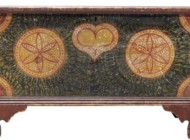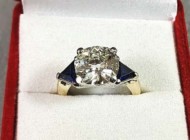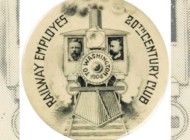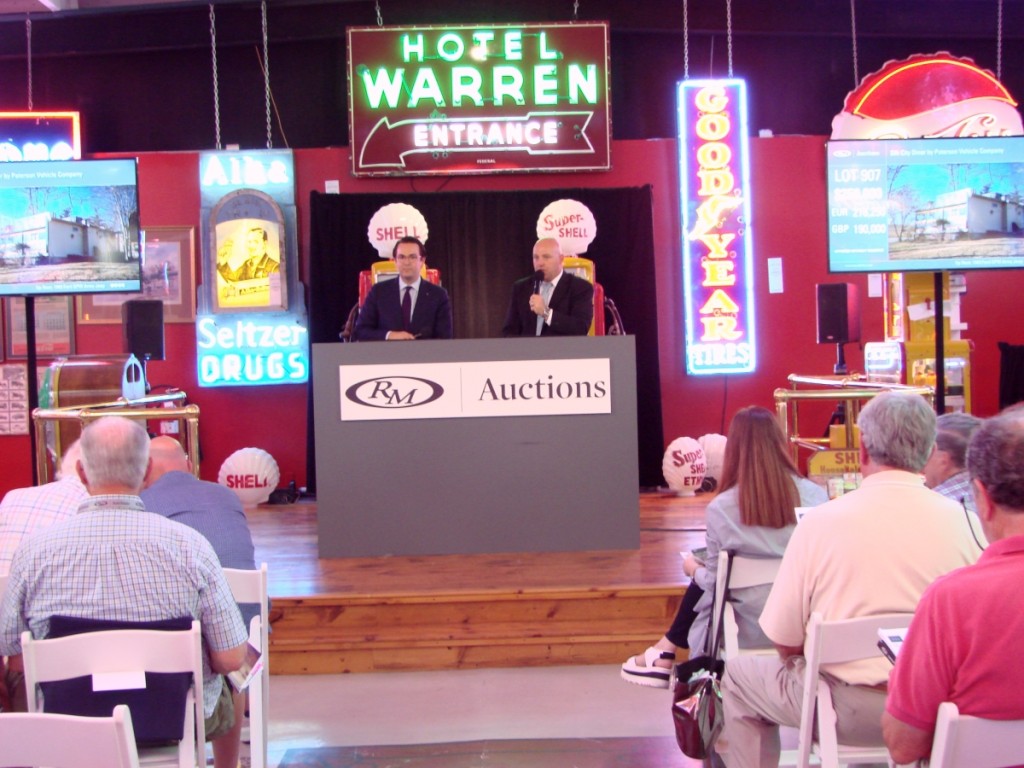
On the left is the chief operating officer of RM Auctions, Alain Squindo, next to auctioneer Mike Shackleton.
Review and Photos by Rick Russack
HAMPTON, N.H. – The third and final part of the Michael Dingman collection was sold June 23-24 by RM Auctions, a division of RM Sotheby’s. Dingman was a director of the Ford Motor Company for more than 20 years, so it is not surprising that products of the company were his first love. He also collected neon and porcelain signs, other automobilia, automotive literature, barber shop equipment, carousel animals, a fully equipped 1940s diner and more. But to say “collected” tells only part of the story. He researched every object he collected and restored nearly all to original or showroom condition, employing only the finest craftsmen, sparing no expense. The sale was held onsite at Dingman’s estate in Hampton and objects were displayed as he had displayed them. The day of the preview was a warm, early summer day, allowing the building’s overhead doors to be open, and allowing cars to be displayed outdoors. Cars were being examined by enthusiasts, and although English was the language in use, the “car talk” among those examining and discussing the cars was a language all its own.
Dingman could afford to drive any car he wanted to, but he and his family primarily drove Ford Motor Company cars. He believed that cars were meant to be driven so he did and, with his wife’s encouragement, took up racing at the age of 60. He was also a Ford historian, collecting literature and photos of the Ford family. To showcase his cars, as the catalog says, “he amassed one of the highest quality collections of neon and porcelain signs and period posters.” The sale included everything in the building: signs, cars, tools, lifts, many rare spare parts and engines. The presentation of the sale was outstanding. The cars and everything else were spotless and RM had a large staff on hand. Catalog descriptions were detailed, photos showed pertinent details and RM assigned a numerical condition rating for each of the signs and explained the standards used. The catalog included charts of shipping and packing costs for signs.
Online bidders knew exactly what they were bidding on and what it would probably cost to get it home. The presale publicity, and comments heard at the sale, emphasized that everything had been fully restored, and the cars were described in superlative terms as being in showroom condition. Dingman’s philosophy towards restoration was to honor the builder’s intent by recreating the original condition. A meticulous collector, he spared no expense in restoring his collection of neon signs, automotive accessories and his cars to the peak of their original showroom condition. This is clearly what bidders wanted, with several of the cars and signs selling substantially over estimates. A collector in the room said, “If you’re going to buy a good car, buying one that has been properly restored is the best way to go. Quality restorations are time-consuming and expensive, so buy one that has been done.” A professional restorer said that Dingman would think nothing of paying $40,000 for a car he wanted and then spending $250,000 to restore it.
The 37 automobiles brought $3,965,750, more than half the total sale. Detailed descriptions of each car are on the RM website. Twelve of the automobiles sold for six-figure prices, topped by $720,000 for a 1995 Ford Roush Mustang Cobra SCCA Trans Am which nearly doubled its estimate. The racecar was used by three-time Sports Car Club of America (SCCA) Trans Am Champion Tommy Kendall, as confirmed by RM’s research team just weeks prior to the sale. Dingman bought it when Rousch was disposing of some cars in 1999; he did not race it but maintained it meticulously.
The second highest priced car of the collection, finishing at $302,000, was a 2006 Ford GT. Designed to commemorate the 100th anniversary of Ford Motor Company in 2004, the GT was powered by Ford’s all-aluminum 5.4-liter V-8 engine. Its original base price was $139,995, and this car had less than 2,400 miles. Selling for $123,200 was a 1946 Ford Super DeLuxe station wagon. Ford was the first United States automaker to resume production after World War II ended, but since they were using parts leftover from prewar models, there were only minor differences between 1946 models and 1942 models.
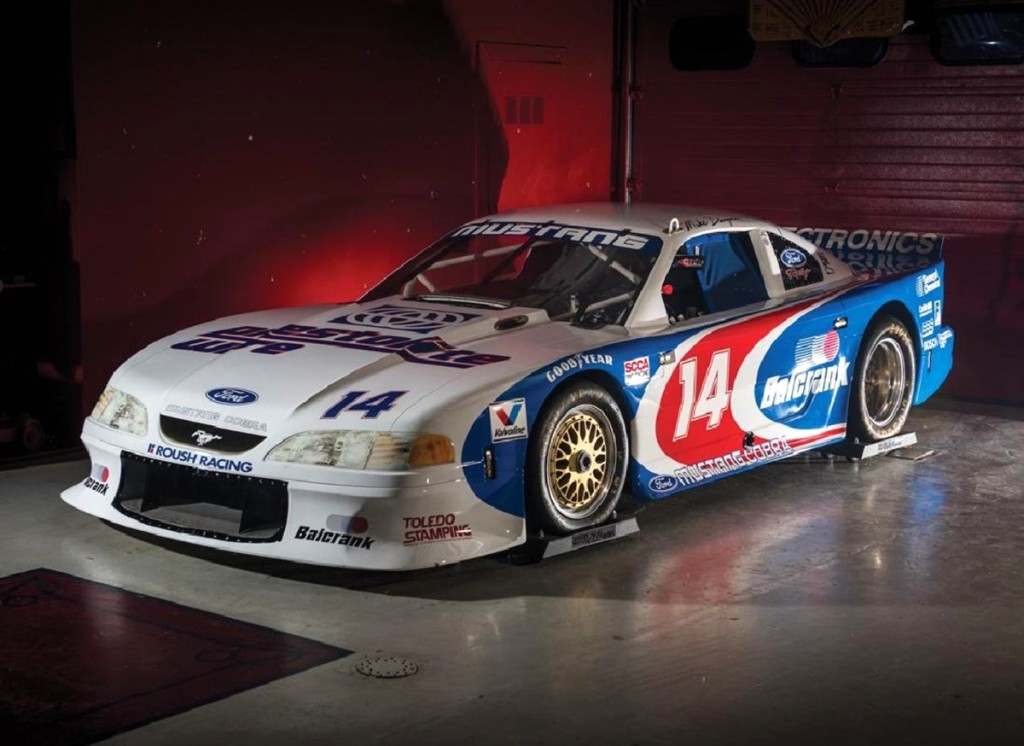
Leading the sale at $720,000, this 1995 Ford Roush Mustang Cobra SCCA Trans Am was the highest priced car in the sale, selling far beyond its estimate to a buyer in the room who patiently outbid several others. Dingman, who had personally competed in many races, had the opportunity to buy this car in 1999.
While Ford products were clearly Dingman’s favorites, this sale included two Porsches and each sold for $134,400. One was a bright ruby red 1965 Porsche 356C 1600 Cabriolet by Reutter. The car had been owned by Dingman for more than 30 years and was a car he drove frequently, showing minor signs of that usage, and the car had been upgraded over the years. By 1965, the 356 model, which had been produced for several years, was about at the end of its run, to be replaced by the 911 series. The second Porsche was a 2014 911 GT3, with less than 2,500 miles and an extensive list of options.
One of the expected highlights of the sale, and finishing with the second highest price of weekend, was a fully restored 1940s Silk City Diner by the Paterson Vehicle Company. It had operated from 1952 until 1989 in Pittsgrove, N.J., and was equipped with a fully functional kitchen and appliances. It was accompanied by an extensive catalog note and a comprehensive written history. In 1994, the diner was sold to diner expert Steve Harwin, who began restoring it at his shop in Cleveland, Ohio. Harwin completed the detailed, authentic restoration in 2003, at which point the diner was delivered to and installed at the Dingman’s New Hampshire estate. It sold for $336,000 to two women in the salesroom, who had come specifically for the diner. While they asked to remain anonymous, they said that they currently operate a hospitality enterprise in Concord, N.H.
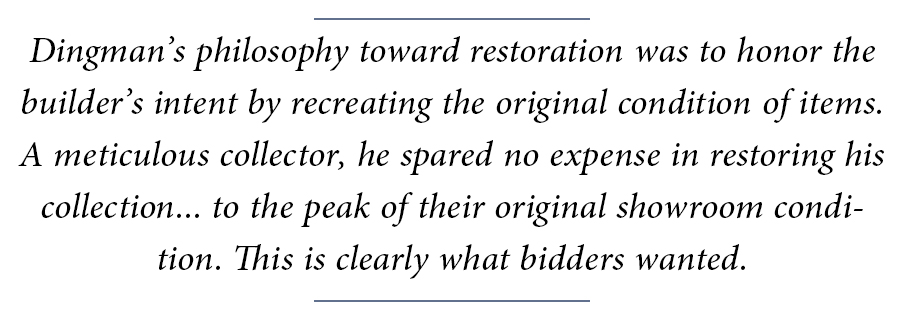 Another of the expected highlights of the sale was a triple-arch backbar built by the Weiss-Sontag Company, of Chicago. Weiss-Sontag was perhaps best known for building this type of bar, as well as for their billiards tables. This model, number 600, was called The Chicago and was the premier backbar in Weiss-Sontag’s line of bars. This backbar is believed to have originally come from a saloon in the Midwest, though little is known of its earliest history. It was often used by Dingman and his friends and it was fully ready to be used again. It realized $81,000.
Another of the expected highlights of the sale was a triple-arch backbar built by the Weiss-Sontag Company, of Chicago. Weiss-Sontag was perhaps best known for building this type of bar, as well as for their billiards tables. This model, number 600, was called The Chicago and was the premier backbar in Weiss-Sontag’s line of bars. This backbar is believed to have originally come from a saloon in the Midwest, though little is known of its earliest history. It was often used by Dingman and his friends and it was fully ready to be used again. It realized $81,000.
The sale was conducted in the buildings that had housed the collection, including the bar described above. There were more than 500 signs, including about 250 neon signs, one of the larger collections in the country. As with the rest of the collection, all had been restored as close as possible to original condition. The signs were in place as Dingman had displayed them. All were working during the sale, which added a tremendous amount of color to the facility. Many of the signs were animated, such as a Greyhound sign with a galloping dog that reached $10,800 and most were automotive related. There were neon signs to appeal to a variety of interests. A large sign for hamburgers and shakes sold for $48,000, far more than its $20,000 estimate. Signs from iconic American brands such as John Deere, Lincoln, Ford and Shell, along with beer signs, hotel signs and others, all performed strongly. A double-sided Ford winged oval neon went for $18,000 and a single sided flashing Dodge Plymouth Dependable Service sign sold for $19,800.
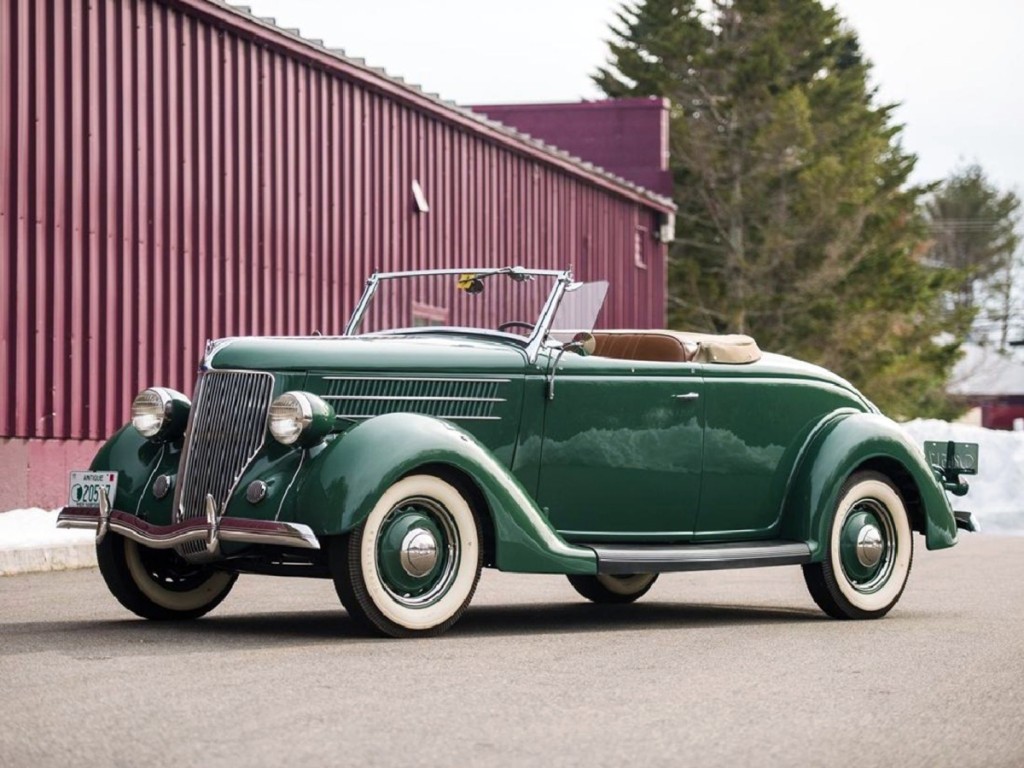
Selling well past its estimate at $140,000, this 1936 Ford V-8 Deluxe Roadster was a very popular car in its day. Dingman had the engine rebuilt by Roush Performance Products. Only 3,862 were built and this one is probably the only one with a Roush-built V8.
The first neon signs in the United States were introduced in Los Angeles by Earle C. Anthony. Anthony owned several automobiles dealerships and gas stations, including the first and only Packard Motor Car Company in California through the 1950s. He first saw neon signs on a visit to Paris in 1921 and commissioned two Packard signs for his showroom. The signs cost $1,250 – about half the price of a 1923 five-passenger Packard Single-Six Touring car – but Anthony’s investment paid off. The signs were a sensation, reportedly causing traffic jams as people stopped to marvel at their intense glow. As technology improved, as many as 40 colors could be produced and the signs remained popular until nighttime blackouts during World War II darkened most and many were never re-lit. They were eventually replaced by cheaper plastic and fluorescent tubes, and originals soon became collector items. Seeing so many in one place showed why.
RM Auctions calls itself the largest auction house dealing in collector cars. For the last four years they were number one in total value of cars sold and number one in number of cars sold for more than $1 million. About three years ago, Sotheby’s acquired a partial interest in the company, which now operates in six states and four foreign countries, including Paris, London and Monaco. Prior to the sale, Alain Squindo, chief operating officer, was asked about items of high value being sold without reserves. “We know that selling unreserved encourages strong, competitive bidding. Buyers know ‘if I don’t get it today, it’s gone.’ It’s worked very well for us and our consignors know our track record. We expect about 300 live bidders for this sale and sometimes we’ve had as many as a thousand. We’ll have 16 phone lines in use and internet bidding is available on two platforms.” After the sale, the company announced that 30 percent of bidders participated via internet, and 20 percent via telephone. They also said that 40 percent of all bidders represented first-time RM Sotheby’s Group clientele. Perhaps astute use of social media contributed to this statistic. Instagram postings for this sale resulted in more than 1,700 “likes.”
All prices include the buyer’s premium as quoted by the auction house. For information, www.rmsothebys.com.





















